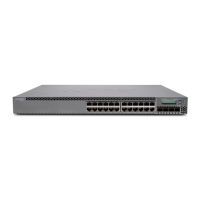•
The polling period that the system uses to record the data
You configure the profiles and define a unique name for each profile using statements
at the [edit accounting-options] hierarchy level. There are two types of accounting profiles:
interface profiles and filter profiles. You configure interface profiles by including the
interface-profile statement at the [edit accounting-options] hierarchy level. You configure
filter profiles by including the filter-profile statement at the [edit accounting-options]
hierarchy level. For more information, see the Network Management Administration Guide
for Routing Devices.
You apply filter profiles by including the accounting-profile statement at the [edit firewall
filter filter-name] and [edit firewall family family filter filter-name] hierarchy levels. For
more information, see the Routing Policy Feature Guide for Routing Devices.
Applying an Accounting Profile to the Physical Interface
To enable accounting on an interface, include the accounting-profile statement at the
[edit interfaces interface-name] hierarchy level:
[edit interfaces interface-name]
accounting-profile name;
You can also reference profiles by logical unit; for more information, see “Configuring
Accounting for the Logical Interface” on page 76.
Example: Applying an Accounting Profile to the Physical Interface
Configure an accounting profile for an interface and apply it to a physical interface:
[edit]
accounting-options {
file if_stats {
size 4m files 10 transfer-interval 15;
archive-sites {
"ftp://login:password@host/path";
}
}
interface-profile if_profile {
interval 15;
file if_stats {
fields {
input-bytes;
output-bytes;
input-packets;
output-packets;
input-errors;
output-errors;
}
}
}
}
[edit interfaces ge-1/0/1]
accounting-profile if_profile;
75Copyright © 2015, Juniper Networks, Inc.
Chapter 2: Configuration Tasks

